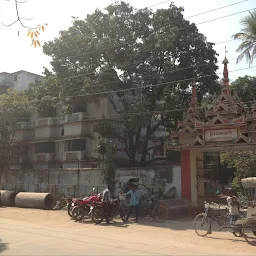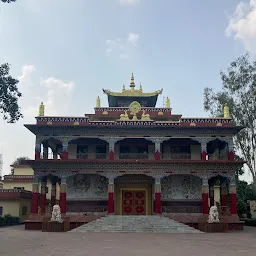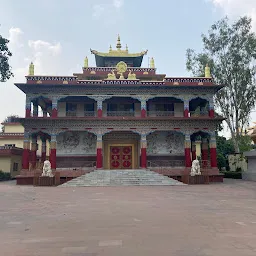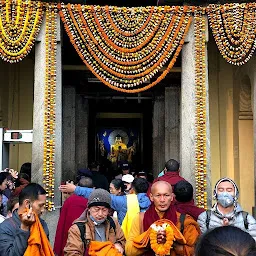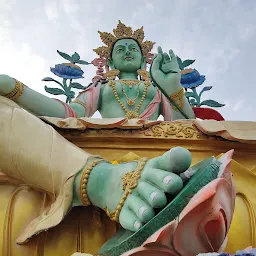Burmese Monastery
Pacchati Main Road, Bodh Gaya, Bihar 824231, IndiaBurmese Monastery is a buddhist temple located in Bodh Gaya, Bihar. The average rating of this place is 4.20 out of 5 stars based on 107 reviews. The street address of this place is Pacchati Main Road, Bodh Gaya, Bihar 824231, India. It is about 3.69 kilometers away from the Basari railway station.
- Where is Burmese Monastery located?
- Burmese Monastery is located at Pacchati Main Road, Bodh Gaya, Bihar 824231, India.
- What is the nearest railway station from Burmese Monastery?
- Basari railway station is the nearest railway station to Burmese Monastery. It is nearly 3.69 kilometers away from it.
Aniket Ankam 22 months ago
Couldn’t go inside as it was closed due to covid but I must say that such an amazing architecture it is.
There are so many beautiful monasteries around the Mahabodhi temple and this one is one of them.
Bodhgaya Tours 34 months ago
Bodhgaya Bihar India tourism destination
The land of enlightenment of Buddha statue bodhgaya
Tour guide with all information ????
ASHARUL 22 months ago
A kyaung (Burmese: ဘုန်းကြီးကျောင်း; MLCTS: bhun:kyi: kyaung:, [pʰóʊɰ̃dʑí tɕáʊɰ̃]) is a monastery (vihara), comprising the domestic quarters and workplaces of Buddhist monks. Burmese kyaungs are sometimes also occupied by novice monks (samanera), lay attendants (kappiya), nuns, and young acolytes observing the five precepts (ဖိုးသူတော် phothudaw).
The kyaung has traditionally been the center of village life in Burma, serving as both the educational institution for children and a community center, especially for merit-making activities such as construction of buildings, offering of food to monks and celebration of Buddhist festivals, and observance of uposatha. Monasteries are not established by members of the sangha, but by laypersons who donate land or money to support the establishment.
Kyaungs are typically built of wood, meaning that few historical monasteries built before the 1800s are extant. Kyaungs exist in Myanmar (Burma), as well as in neighboring countries with Theravada Buddhist communities, including neighboring China (e.g., Dehong Dai and Jingpo Autonomous Prefecture). According to 2016 statistics published by the State Sangha Maha Nayaka Committee, Myanmar is home to 62,649 kyaungs and 4,106 nunneries.
The modern Burmese language term kyaung (ကျောင်း) descends from the Old Burmese word kloṅ (က္လောင်).The strong connection between religion and schooling is reflected by fact that the kyaung is the same word now used to refer to secular schools. Kyaung is also used to describe Christian churches, Hindu temples, and Chinese temples. Mosques are an exception, as they use the Hindi-derived word bali (ဗလီ).
Kyaung has also been borrowed into Tai languages, including into Shan as kyong (spelt ၵျွင်း or ၵျေႃင်း)and into Tai Nuea as zông2 (ᥓᥩᥒᥰ, rendered in Chinese as Chinese: 奘房).In pre-colonial times, the kyaung served as the primary source of education, providing nearly universal education for boys, representing the "bastion of civilization and knowledge" and "integral to the social fabric of pre-colonial Burma." The connections between kyaungs and education were reinforced by monastic examinations, which were first instituted in 1648 by King Thalun during the Taungoo Dynasty. Classical learning was transmitted through monasteries, which served as venues for Burmese students to pursue higher education and further social advancement in the royal administration after disrobing.Indeed, nearly all prominent historical figures such as Kinwun Mingyi U Kaung spent their formative years studying at monasteries.
Traditional monastic education first developed in the Pagan Kingdom, in tandem with the proliferation of Theravada Buddhism learning in the 1100s.The syllabus at kyaungs included the Burmese language, Pali grammar and Buddhist texts with a focus on discipline, morality and code of conduct (such as Mangala Sutta, Sigalovada Sutta, Dhammapada, and Jataka tales), prayers and elementary arithmetic. Influential monasteries held vast libraries of manuscripts and texts.The ubiquity of monastic education was attributed with the high literacy rate for Burmese Buddhist men.The 1901 Census of India found that 60.3% of Burmese Buddhist men over twenty were literate, as compared to 10% for British India as a whole...
- Address
- Pacchati Main Road, Bodh Gaya, Bihar 824231, India
